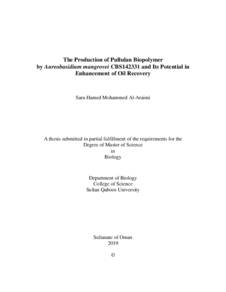Document
The Production of Pullulan Biopolymer by Aureobasidium mangrovei CBS142331 and Its Potential in Enhancement of Oil Recovery
Publisher
Sultan Qaboos University
Gregorian
2019
Language
English
English abstract
Even with recent efforts to find new renewable energy resources, the world economy still depends heavily on crude oil. With conventional oil recovery processes, only one third of crude oil is extracted. Different technologies were developed to maximize the recovery of precious oil resources out of the natural reservoirs. Polymer technology is a wide and successful approach used in many oil fields around the world. Pullulan is a biopolymer produced by some species of genus Aureobasidium as a highly hydrated layer surrounding their cells to protect them from dehydration and prevent the predators attack. Pullulan has long been exploited in many fields such as food, cosmetic, and manufacturing industries, but no research was conducted on using pullulan for enhancement of oil recovery. In this study, a local strain of Aureobasidium was isolated, morphologically and molecularly characterized. Based on molecular analysis of internal transcribed spacer (ITS) and large ribosomal subunit (LSU) genes, the isolated strain has 100% similarity with Aureobasidium mangrovei. The fungus has similar morphology with A. mangrovei on PDA, YPG and SDA. This isolate was named as A. mangrovei CBS142331. Pullulan was produced by fermentation and was optimized based on carbon source, pH, temperature and agitation speed. Furthermore, pullulan was extracted and chemically characterized using high performance liquid chromatography (HPLC) and fourier-transform infrared spectroscopy (FTIR). For the use of pullulan in microbial enhanced oil recovery (MEOR), rheology, stability and injectivity studies were conducted. Recovery of light and heavy oil with aid of pullulan was evaluated using core flooding experiment. At optimum conditions (sucrose, pH 9, 25 °C and 250 rpm), the fungus was able to produce a maximum of 10 g/L of pullulan. FTIR and HPLC confirmed that the product extracted is pullulan. Based on the viscosity, pullulan is considered as non-newtonion fluid and has shear thinning behavior. However, the viscosity was stable at different concentrations of NaCl (1%- 20%) and at a range of pH (2-10) during 230 days of incubation. For light oil recovery, pullulan extracted 34 % from the residual oil in place after water flooding. However, for heavy oil recovery, 36.7% was recovered by undiluted pullulan and 20.23% by diluted pullulan in brine (1:1). Pullulan showed good injectivity and passed smoothly through the core without causing blockage during 20 days on injection. In conclusion, pullulan extracted from local strain of A. mangrovei CBS142331 is able to increase the oil recovery with a high percentage comparable with polymers used in oil filed around the world.
Description
Thesis
Member of
Resource URL
Category
Theses and Dissertations

